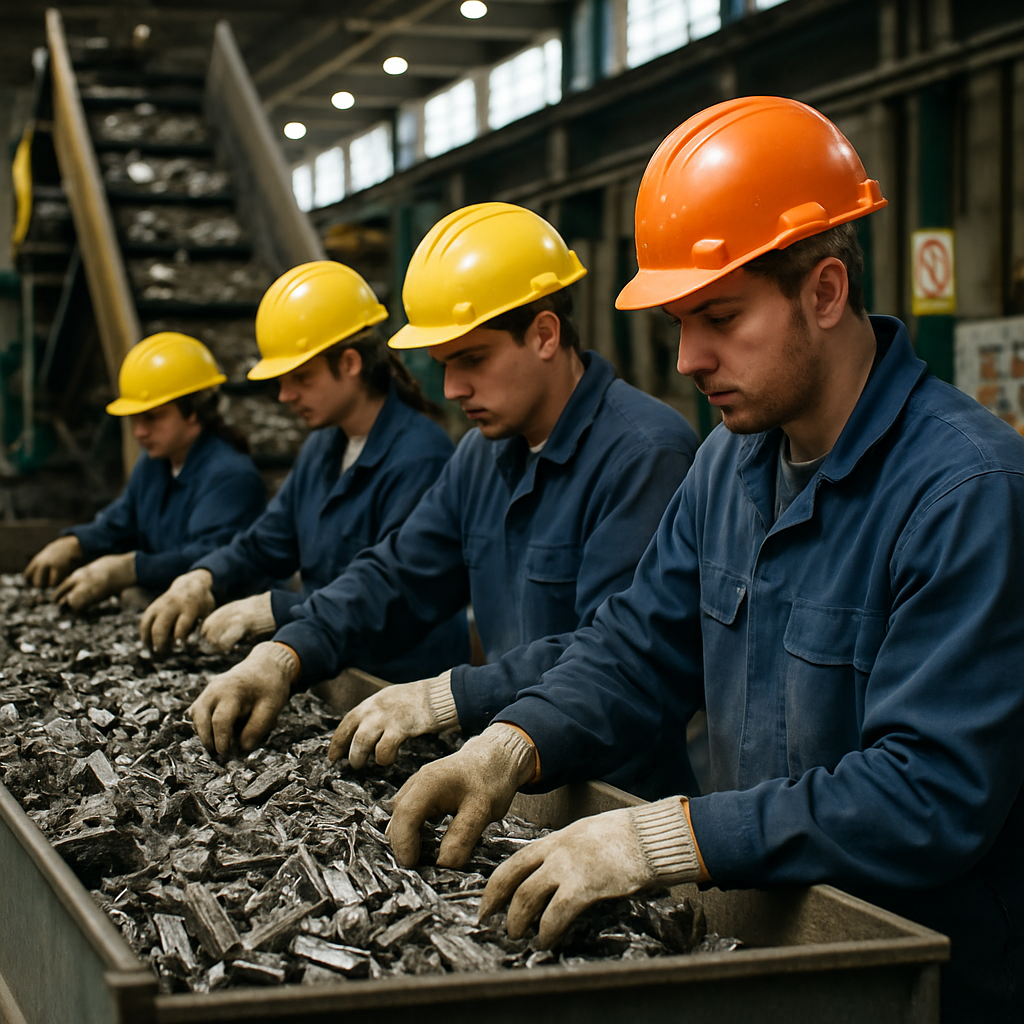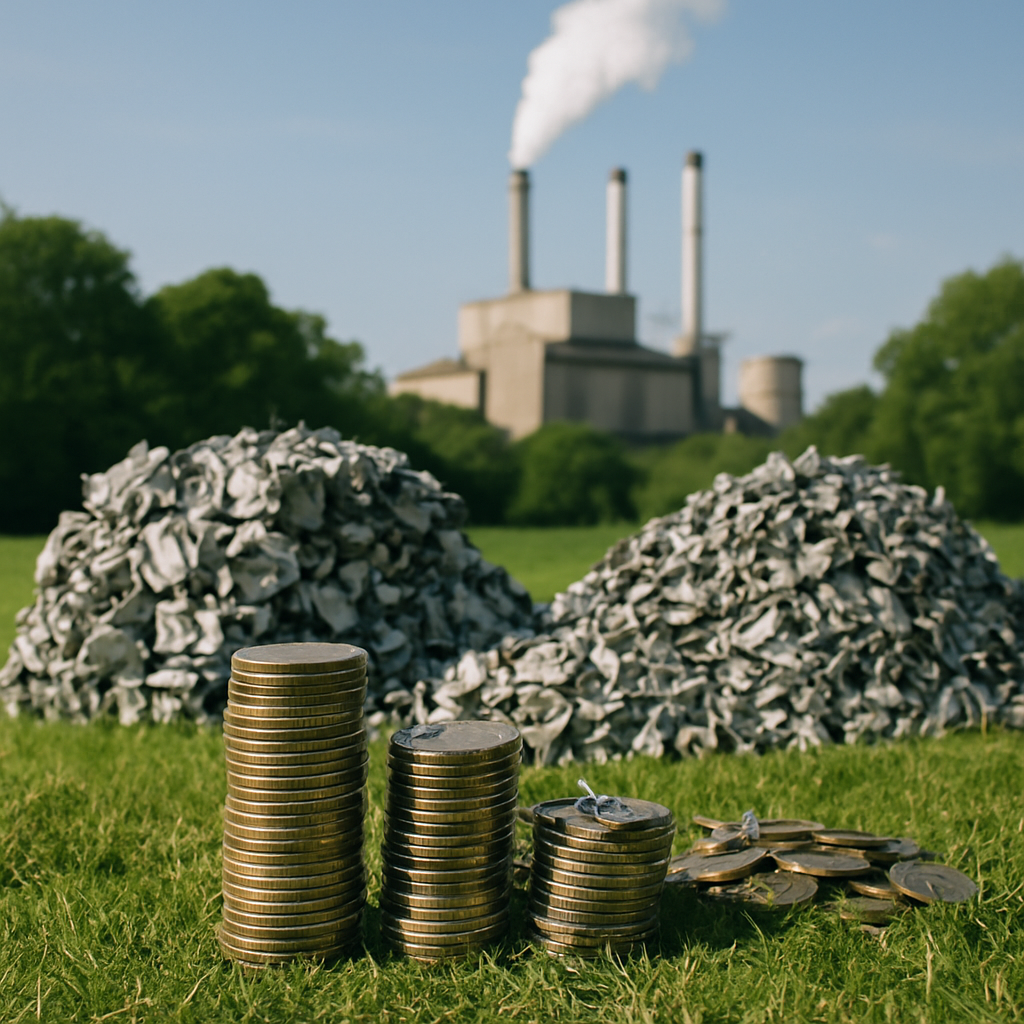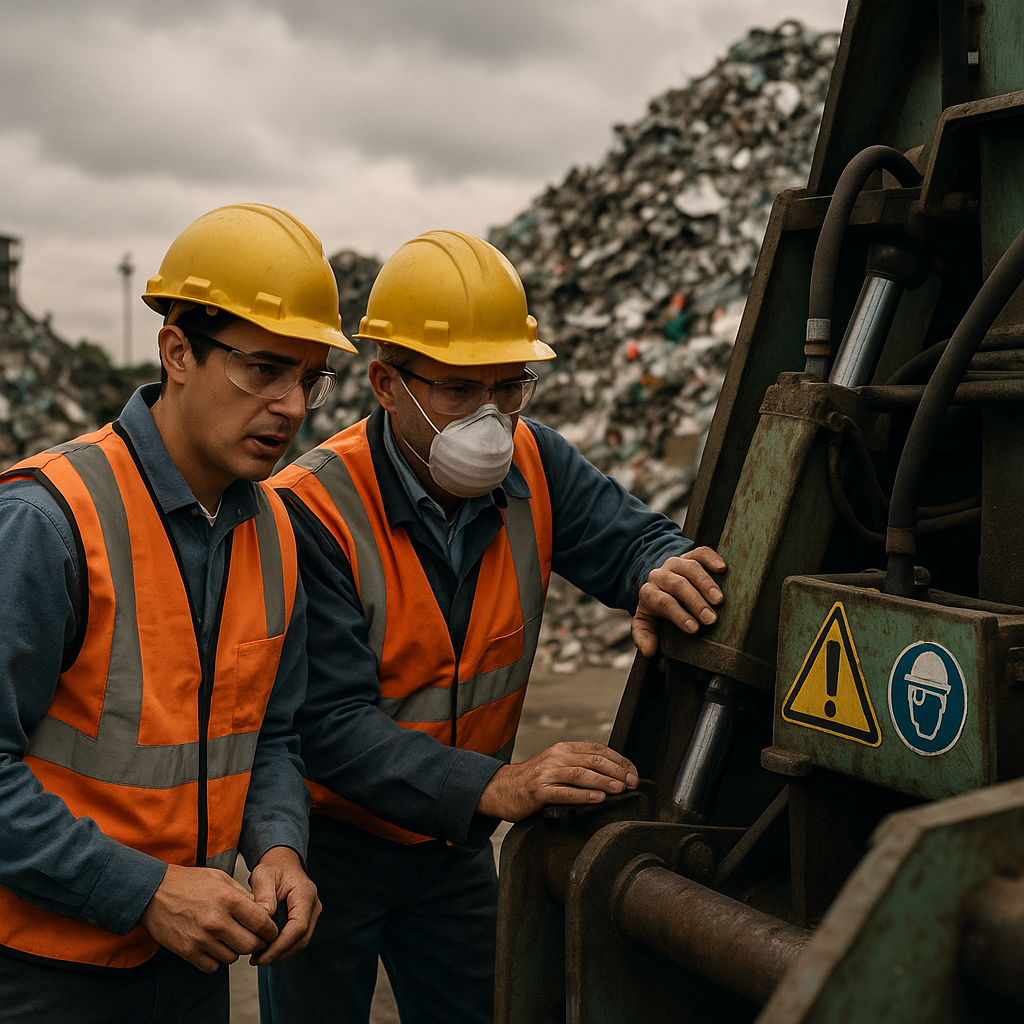5901 Botham Jean Blvd, Dallas, TX 75215
Metal Recycling Value Chain: Stages, Benefits, and Industry Challenges
October 17, 2025The metal recycling value chain illustrates the complete journey that scrap metals take from collection to transformation into new products. This process revitalizes materials that would otherwise contribute to landfill waste. When your old refrigerator or car reaches the end of its life, it enters this efficient system, turning waste into valuable resources.
At its core, the metal recycling value chain involves several interconnected stages. It begins with collection, where scrap yards, municipal programs, and specialized facilities gather discarded metals. Next, the materials undergo sorting processes to separate different metal types, crucial for maintaining material purity and value. The metals then proceed through processing steps including shredding, melting, purification, and are finally molded into new raw materials ready for manufacturing.
This circular approach offers significant environmental and economic benefits. The process substantially reduces energy consumption compared to mining virgin ore. For example, recycling aluminum saves up to 95% of the energy required for primary production. This system also conserves natural resources by reducing the need for extractive mining while creating jobs in the collection, processing, and manufacturing sectors.
What Are the Key Stages in the Metal Recycling Process?

Metal recycling turns discarded materials into valuable resources through a series of specialized stages. Each step in this process is essential for producing high-quality recycled metal while reducing environmental impact. Let’s explore these key stages in detail.
Collection and Recovery
The journey begins with collecting metal waste from various sources. Unlike other recyclables, metals often have higher scrap value, making them more likely to be sold to scrap yards. Construction sites, industrial facilities, and even residential areas serve as primary collection points.
In California and other states with robust recycling programs, specialized collection centers and curbside pickup services help facilitate this process. Scrap vehicles represent one of the largest sources of ferrous metal in the United States, contributing significantly to the recycling stream.
Businesses and manufacturing facilities also generate substantial amounts of scrap metal, often establishing direct relationships with recycling centers for regular collection. This initial stage sets the foundation for the entire recycling process.
Sorting and Identification
Once collected, scrap metals undergo thorough sorting. This critical quality control phase separates recyclable metals from non-recyclables and categorizes them by type. Ferrous metals (containing iron) are separated from non-ferrous metals (like aluminum, copper, and brass) using magnetic separation techniques.
Advanced recycling facilities employ specialized equipment such as magnetic separators, eddy current systems, and sensor-based sorting technologies. Manual inspection also plays a vital role in ensuring proper categorization. The sorting process maximizes efficiency by preventing contamination between different metal types.
This stage directly impacts the value and quality of the final recycled product. Non-ferrous metals like copper and aluminum typically command higher prices due to their resistance to corrosion and higher conductivity.
Processing and Compacting
After sorting, the metals enter the processing stage. Here, the materials are prepared for melting through various techniques. Large pieces are cut down to manageable sizes. The scrap is cleaned to remove non-metallic materials that could contaminate the final product.
Specialized machines compact the sorted metals into dense bales or blocks. This process minimizes volume, making transportation more efficient and the subsequent melting process more effective. Compacting also allows recycling facilities to handle larger quantities of material within limited space.
The processing stage improves overall efficiency by reducing the energy requirements for later steps in the recycling chain. Properly processed scrap requires less energy to melt and produces fewer emissions during the melting phase.
Shredding Operations
Shredding further reduces the metal into smaller, uniform pieces with a large surface-to-volume ratio. Purpose-built industrial shredders transform bulky scrap into smaller fragments that will melt faster and more uniformly.
This step is particularly important for complex items like vehicles or appliances that contain multiple types of metals. Shredding helps expose different materials for better separation in subsequent stages. The smaller size also reduces the energy needed for melting.
Modern shredding facilities employ sophisticated technology to maximize recovery rates while minimizing dust and noise pollution. Some operations incorporate additional separation systems at this stage to capture any remaining non-metallic materials.
Melting in Specialized Furnaces
The shredded metal enters furnaces specifically designed for each metal type. Steel, aluminum, copper, and other metals require different melting temperatures and conditions. Electric arc furnaces are commonly used for steel recycling, while reverberatory or induction furnaces may be used for non-ferrous metals.
Temperature control is crucial during this stage. Steel melts at approximately 1510°C (2750°F), while aluminum has a much lower melting point of around 660°C (1220°F). Despite the significant energy required, recycling metals uses substantially less energy than processing virgin materials. Recycling aluminum, for instance, uses 95% less energy than producing new aluminum from bauxite ore.
The furnaces transform solid scrap into molten metal, preparing it for the purification process. This stage represents the transition point where discarded items truly begin their transformation into new resources.
Purification Techniques
Purification removes impurities from the molten metal to ensure the recycled material meets quality standards. Several methods achieve this, including fluxing, which adds chemicals to separate impurities that form removable slag on the surface.
For higher-purity applications, electrolysis may be used, particularly with metals like copper. This process uses electric current to separate and remove impurities. Degassing techniques remove dissolved gases that could cause defects in the finished product.
The level of purification depends on the intended use of the recycled metal. Some applications require exceptionally pure metal, while others can tolerate small amounts of certain elements. Quality control testing during this stage ensures the metal meets specific standards.
Solidification and Manufacturing
The final stage transforms purified molten metal into usable forms. The metal is cooled and solidified into standardized shapes such as ingots, bars, billets, or sheets that manufacturers can easily use. These basic forms serve as the raw material for creating new products.
Manufacturers across various industries incorporate these recycled metals into their production processes. Recycled aluminum might become automotive components or beverage cans. Steel finds new life in construction materials or appliances. Copper may be used in electrical wiring or plumbing fixtures.
This stage completes the recycling loop, with formerly discarded materials becoming valuable inputs for new products. When these products eventually reach the end of their useful life, they can enter the recycling process again, creating a sustainable circular economy for metals.
| Stage | Process Description | Environmental Benefit |
|---|---|---|
| Collection | Gathering discarded metals from various sources like construction sites, industrial facilities, and residential areas. | Ensures metals are recycled rather than sent to landfills. |
| Sorting | Separating metals by type using techniques like magnetic separation and manual inspection. | Maximizes material purity and prevents contamination. |
| Processing | Preparing metals for melting by cutting, cleaning, and compacting them into manageable sizes. | Minimizes volume and energy requirements for melting. |
| Shredding | Reducing metal into smaller pieces to speed up melting and improve separation. | Decreases energy needed for melting. |
| Melting | Using specialized furnaces to melt metals into a liquid state. | Consumes less energy than mining virgin materials. |
| Purification | Removing impurities from molten metal through fluxing and electrolysis. | Ensures high-quality recycled material. |
| Solidification | Cooling and shaping molten metal into usable forms like ingots and sheets. | Creates raw materials for new products, continuing the recycling loop. |
What Are the Environmental and Economic Benefits of Metal Recycling?

Metal recycling significantly reduces greenhouse gas emissions compared to primary metal production. Recycling aluminum cuts CO2 emissions by a remarkable 92%, while steel recycling achieves a 58% reduction. These reductions are crucial in combating climate change and improving air quality in nearby communities.
The energy savings from metal recycling are substantial. Recycling aluminum requires 95% less energy than extracting and processing raw bauxite. Steel recycling saves 72% of the energy needed for primary production, translating to approximately 4,697 kilowatt-hours saved per ton of recycled steel. Copper recycling offers similar benefits, cutting energy needs by up to 85%.
Beyond emissions and energy conservation, recycling metals saves natural resources. Every ton of recycled steel saves 1.4 tons of iron ore, 0.8 tons of coal, and 0.3 tons of limestone. The conservation also extends to water resources, as recycled steel reduces water usage by 40% and decreases water pollution by 76%.
The economic benefits of metal recycling are equally impressive. The global metal recycling market continues to expand, creating jobs across collection, sorting, processing, and manufacturing sectors. Recycling is labor-intensive, providing employment for skilled workers specializing in material recovery.
Metal recycling reduces dependence on imported materials. For example, the European Union produces only about 3% of the primary raw materials it needs. Robust recycling programs enable regions to decrease reliance on foreign materials and stabilize supply chains against global market fluctuations.
For businesses, recycling metals generates cost savings and additional revenue streams. Companies can reduce production expenses by utilizing recycled materials, which typically cost less than virgin resources. What was once considered waste becomes a valuable commodity sold to recycling facilities.
The Environmental Protection Agency reports that metal recycling reduces greenhouse gas emissions by approximately 29 million tons of carbon dioxide annually, equating to the yearly emissions from 6.3 million cars. The environmental benefits extend to reduced landfill usage and decreased soil contamination from mining operations.
Metal recycling also helps businesses enhance their brand image. In today’s environmentally conscious market, companies demonstrating a commitment to sustainability attract environmentally aware customers, investors, and potential employees.
The circular nature of metal recycling is one of its greatest strengths. Unlike many materials that degrade during recycling, metals maintain their integrity and quality through multiple cycles. Aluminum and steel can be recycled indefinitely without losing their essential properties.
Thanks to this limitless recyclability, approximately 75% of all aluminum ever produced remains in use today, with steel at around 70%. This longevity highlights the lasting value of investing in metal recycling infrastructure and programs.
What Challenges Face the Metal Recycling Industry?

The metal recycling sector is crucial for conserving resources and supporting sustainable manufacturing. Despite its importance, the industry faces several significant challenges. Contamination issues are among the most pressing concerns.
Impurities in scrap metal create substantial processing difficulties. When materials like plastic, rubber, or hazardous substances mix with recyclable metals, costly separation becomes necessary. These contaminants slow operations and require additional resources, ultimately reducing efficiency throughout the recycling pipeline.
The complexity of modern product design presents another major hurdle. Many electronic devices contain numerous metals tightly integrated with other materials. Smartphones, for instance, contain around 40 different metals in configurations that make separation extremely difficult. This complexity directly affects the economic viability of e-waste recycling.
Long product lifespans introduce unique timing challenges. Metal products like infrastructure components, vehicles, and building materials may remain in use for decades before they are available for recycling. This delayed return creates gaps in the material supply chain and complicates planning for recycling operations.
Market volatility represents a persistent source of uncertainty. Global economic conditions, trade policies, and supply-demand imbalances cause substantial fluctuations in recycled metal prices. During economic downturns, reduced demand for certain metals can significantly lower prices, making operations less profitable for recyclers who must maintain consistent facilities regardless of market conditions.
Technological limitations continue to constrain the industry’s effectiveness. While sorting technologies have improved, many facilities still struggle with efficiently separating and processing certain types of metals. Advanced metals and alloys often require specialized equipment that smaller recycling operations cannot afford.
Regulatory complexities and trade barriers further complicate metal recycling. Inconsistent regulations across regions create confusion for companies operating globally. Policies such as tariffs impact international scrap flows, as seen when China introduced strict quality standards for imported metal scrap, disrupting traditional supply chains.
Infrastructure limitations compound these challenges in some areas. Outdated facilities, insufficient collection systems, and transportation bottlenecks create inefficiencies that reduce the overall effectiveness of metal recycling efforts.
Quality control concerns impact downstream applications. Consistent quality in recycled metals is essential for industries with rigorous standards, such as automotive and aerospace manufacturing. Without advanced technology and quality control measures, recycled materials may not meet these specifications.
Conclusion: The Future of the Metal Recycling Value Chain

The metal recycling value chain is crucial in our transition toward a sustainable, circular economy. As global demand for metals grows with expanding industries and clean technologies, recycling offers a practical solution to preserve natural resources while significantly reducing environmental impact. Metal recycling isn’t just an alternative to mining; it is an essential complement that addresses resource scarcity and emission concerns.
The industry is evolving rapidly. Advanced sorting technologies powered by artificial intelligence and robotics are enhancing the efficiency of recycling processes. These innovations enable the extraction of valuable metals from increasingly complex products with greater precision and less energy consumption. Meanwhile, a growing emphasis on designing products for recyclability will further improve material recovery rates and create closed-loop systems where metals retain their value indefinitely.
For your metal recycling needs and to contribute to this sustainable future, contact Okon Recycling at 214-717-4083.
